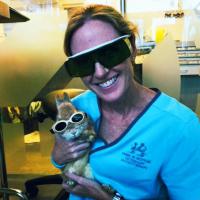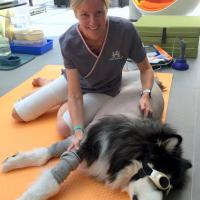MLS® Laser Therapy is always more international. Thanks to its effectiveness, its lack of contraindications and the simplicity of its application, the therapy developed by ASAlaser and applied successfully even in the animal world continues converting vets. Dr. Jane McNae has been using it in “Paws in Motion”, her Vet clinic in Hong Kong, since February 2015 to treat the common health problems of pets. Working in team with those vets who are skilled in pet rehabilitation and physiotherapy is Mphi Vet Orange, a cutting edge device for MLS® created from research and ASA’s technological development.
Q. MLS® and Mphi Vet Orange have been part of your Clinic for more than 6 months. What convinced you to use it?
A. Working with physiotherapy in the vet field, I chose MLS® Laser Therapy because the benefits of this therapeutic laser are essential for managing pain and inflammation, and for improving natural body healing in many post-surgery cases of orthopaedics, neurology and those disturbances commonly found in older pets.
Q. Let’s talk about the devices: what’s your personal opinion of Mphi Vet Orange? Its strong points?
A. When I have to treat a pathology, I am very precise about therapy selection and application, which must be located. With lasers, for example, I much prefer point to point treatment rather than scanning, because it avoids an accumulation of heat in the tissues and the resulting discomfort of the animal. After a lot of research, I discovered MLS® Laser Therapy and the Mphi Vet Orange device, and I understood that I had finally found the solution I was looking for: a laser with wavelengths of 905 and 808nn that could preferentially stimulate different chromophores such as haemoglobin and cytochrome C, increase the production of ATP energy and guarantee in-depth penetration.
Q. Given your experience, what 3 words would you use to describe MLS®?
A. Efficiency, effectiveness, quality.
Q. Words that have been applied in many different cases. Are there, however, some pathologies where MLS® works best?
A. MLS® is useful for facing different pathologies, but it works best for rehabilitating patients with muscle-skeleton pain, oedema, inflammation, distortions, sprains, osteoarthritis and neurological conditions. Last but not least, it heals wounds quickly.
Q. Can you give us an example of some cases?
A. I usually work with old animals suffering from multiple articular arthrosis: I see them weekly to check how the therapy I use with them is progressing. At the same time, I always inform their owners of how benefits can appear after only 3 or 4 weeks. With MLS® instead, the times shorten notably: those same owners send me emails and call me to indicate how much more active their animal is after the first treatment when MLS® Laser Therapy is combined with manual therapy. It is a top level result that I attribute to pain modulation and an improvement in the blood flow.
Q. Let’s talk about the owners. They seem to be enthusiastic after having physically seen the effectiveness of the therapy. But how do they react before application, when you propose it?
A. The owners are amazed, firstly about the existence of a device that was studied specifically for treating their animals, but then they are also curious to see the settings I select for the case to be treated directly on the display. To help them understand the therapy, I tell them how ASAlaser created algorithms specifically for different animal types and for their specific conditions. They are pluses that allow me to concentrate more on the animal rather than on the machine. The speed of the results obtained does the rest.
Q. You spoke about the importance of the algorithms developed specifically for the animal type and pathology: which ones do you use most?
A. For daily cases I use those that focus on pain and inflammation, both acute and chronic, but which also use protocols specifically for muscle contractions, oedema, trigger points. I also appreciate, however, the possibility of setting an ad hoc treatment for each specific problem.
Q. To finish: your Centre also specialises in acupuncture…does MLS® Laser Therapy offer support also in this direction?
A . I work with acupuncture or acu-laser using both the traditional points indicated by Chinese veterinary medicine as described in the TCVM texts, and also the trigger points present in the myofascial tissues of the individual animals. Rabbits, cats and generally pets with neurological weakness obtain the most benefit. MLS® has shown itself to be valid even in this situation, making it possible to act quickly in specific points.


